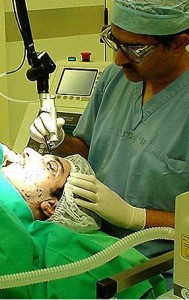
Laser Resurfacing
In the past, skin resurfacing was carried out using chemical peel or dermabrasion (a sanding technique). However, lasers have pretty much replaced the techniques for deeper resurfacing because it seems to offer added safety and faster recovery. Our experience with the laser for skin resurfacing has been very positive. We are impressed with the control that this modality offers. We agree that healing time is shortened, compared to other methods.
Laser resurfacing is often utilized as a compliment to surgery. It is not a substitute for the face lift operation as it does not correct facial laxity or sagging skin. It is excellent for treating fine lines on the cheeks, beneath the eyes and around the mouth – the very lines that are difficult to correct with surgery. Although some patients will have resurfacing as an isolated procedure, more often in our practice, it is coupled with face lift surgery.
One major advantage noted with the laser resurfacing in comparison with the older technique of deep chemical peeling is a decrease in the risk of skin lightening and scarring as reported in several clinical studies. While these risks are not eliminated, they seem to be less frequent. Another advantage is that the depth of treatment is more controllable.
Fractional laser resurfacing is a new method of skin rejuvenation. What sets this apart from other laser resurfacing methods is that only treats a fraction of the skin, leaving the surrounding areas alone. This allows a faster or virtually no downtime than the earlier laser technologies.
A fractional approach to resurfacing means that only specific areas are targeted using lights that are delivered in small, closely spaced micro beams. Both the epidermis and dermis are penetrated. Only a small proportion of the skin receives the laser light, while the other zones in between are left intact.
This way, the skin heals much faster because only fractional damage was caused by the heat of the light source. The micro injured cells start the process of healing with collagen remodeling. The healthy unaffected tissues help to fill in the damaged area with new cells.
The skin tightens and its texture improves. The treatment is comparable to a pixel by pixel retouching of a digital photograph.
Skin Conditions that can be treated with Fractional Laser Resurfacing
· Wrinkles
· Acne scars
· Traumatic scars
· Sun damage
· Brown spots
Contraindications/ Precautions
People with a history of skin sensitivity to light, or have an active infection near the site to be treated are not allowed to undergo the fractional laser resurfacing. The use ofretinoids for acne treatment within the past 12 months is also contraindicated.
Darker skin types must be properly evaluated by a doctor because of some issues of fractional lasers with these skin groups. Ethnic skin has a tendency to develop hyper pigmentation post fractional laser resurfacing. Your physician may recommend an adjunctive regimen to help counter this unpleasant effect.
Pregnant or breastfeeding mothers should delay the treatment because the safety of the fractional laser resurfacing on them is still not well- established.
The Treatment Process
The process is reported to be well tolerated by most patients. There may be some mild prickling or burning sensation. An anaesthetic cream may be applied on your skin prior to the fractional laser resurfacing to reduce any pain or discomfort.
The fractional laser resurfacing usually finished in less than 30 minutes.
Post Treatment
You can return to your usual activities after the session but for the first week your skin may be red and swollen. There may be a sunburn sensation lasting for a few hours to a few days. Cooling gels may be applied to relieve the discomfort.
For most fractional laser resurfacing systems, make-up can be used immediately to camouflage the redness. Your skin will be extremely sensitive to light, so avoid basking in the sun during this period. Sunscreens with high SPF will be useful.
Usually, multiple sessions are required for optimal results. Around 3 to 5 treatments are necessary, with 5 to 7 days interval. The exact number of treatments you will need will be determined by your plastic surgeon.
Dramatic improvements of the skin condition are typically observed in 2 to 3 months. The effects are lasting but not permanent. If you’d rather have a single yet more permanent solution, plastic surgery is an option. Face lifts, for example, will tighten the skin to reduce wrinkles with more permanent results.
Laser skin resurfacing will improve your self confidence and restore a more youthful appearance to your skin.

 Twitter
Twitter Facebook
Facebook Instagram
Instagram Google +
Google +